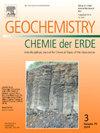Coprecipitation of Ce with lead phosphates
IF 2.9
3区 地球科学
Q2 GEOCHEMISTRY & GEOPHYSICS
引用次数: 0
Abstract
Current development of sustainable technologies creates a demand for new sources of Rare Earth Elements (REE). Recent studies suggest that coprecipitation in the form of Pb-phosphates is one of the most effective methods in REE removal from aqueous solutions. This work focuses on the experimental study of the mechanisms of Ce coprecipitation with Pb phosphates, in particular with lead apatite - pyromorphite (Pb5(PO4)3Cl). Coprecipitation experiments were conducted at ambient conditions, at pH range 1–11, by mixing solutions containing high concentrations of Pb and Ce (∼66,700 ppm and ∼ 7600 ppm, respectively) with solutions containing stoichiometric concentrations of PO4 and Cl. As a result of coprecipitation with Pb phosphates, the Ce concentration decreased significantly to <2 ppm. The main product of the coprecipitation was Ce-doped pyromorphite (Pym![]() Ce). Removal of Ce was most effective under alkaline conditions, while performance was slightly worse under acidic conditions, due in part to the slightly higher solubility of the precipitate. This was compared with a series of control experiments in the absence of either Pb, Cl, or Ce. Precipitation in the absence of Pb resulted in the formation of fibrous rhabdophane-Ce. In the absence of Cl, various phases were formed depending on pH conditions, such as ‘phosphoschultenite’ (PbHPO4), Pb-hopeite (PbPb2(PO4)2·nH2O), mixed Pb and Ce hydrous phosphates, and hydroxylpyromorphite (Pb5(PO4)3OH). In the absence of Ce, pure microcrystalline pyromorphite precipitated. Coprecipitation of Ce with Pb phosphates in the presence of Cl is advantageous due to the recovery of almost all Ce from solution in the form of a micro-crystalline Pym-Ce that is a very stable, insoluble phase easily separated from suspension. The precipitation of Pym-Ce is homogenous over a wide range of pH, assuring consistency in the obtained phases regardless of starting conditions. Achieved high Ce removal levels may be crucial for the progress of the REE extraction industry, in terms of this method being applicable to other REE for their recovery from solutions, including apatite leachates.
Ce). Removal of Ce was most effective under alkaline conditions, while performance was slightly worse under acidic conditions, due in part to the slightly higher solubility of the precipitate. This was compared with a series of control experiments in the absence of either Pb, Cl, or Ce. Precipitation in the absence of Pb resulted in the formation of fibrous rhabdophane-Ce. In the absence of Cl, various phases were formed depending on pH conditions, such as ‘phosphoschultenite’ (PbHPO4), Pb-hopeite (PbPb2(PO4)2·nH2O), mixed Pb and Ce hydrous phosphates, and hydroxylpyromorphite (Pb5(PO4)3OH). In the absence of Ce, pure microcrystalline pyromorphite precipitated. Coprecipitation of Ce with Pb phosphates in the presence of Cl is advantageous due to the recovery of almost all Ce from solution in the form of a micro-crystalline Pym-Ce that is a very stable, insoluble phase easily separated from suspension. The precipitation of Pym-Ce is homogenous over a wide range of pH, assuring consistency in the obtained phases regardless of starting conditions. Achieved high Ce removal levels may be crucial for the progress of the REE extraction industry, in terms of this method being applicable to other REE for their recovery from solutions, including apatite leachates.
铈与磷酸铅的共沉淀
当前可持续技术的发展创造了对稀土元素(REE)新来源的需求。近年来的研究表明,以磷酸铅形式的共沉淀法是去除水溶液中稀土元素最有效的方法之一。本文主要研究了Ce与磷酸铅,特别是与铅磷灰石-焦闪石(Pb5(PO4)3Cl)共沉淀的机理。共沉淀实验在环境条件下进行,pH范围为1-11,通过将含有高浓度Pb和Ce(分别为~ 66,700 ppm和~ 7600 ppm)的溶液与含有化学计量浓度的PO4和Cl的溶液混合。由于与磷酸铅共沉淀,Ce浓度显著降低至2ppm。共沉淀的主要产物为掺ce焦闪石(PymCe)。在碱性条件下,铈的去除效果最好,而在酸性条件下,效果略差,部分原因是沉淀的溶解度略高。这与不含铅、氯或铈的一系列对照实验进行了比较。在没有Pb的情况下,沉淀导致纤维横纹石- ce的形成。在没有Cl的情况下,根据pH条件不同,形成了不同的相,如“磷辉石”(phbhpo4)、铅-希望矿(PbPb2(PO4)2·nH2O)、铅-铈混合水合磷酸盐和羟基焦闪石(Pb5(PO4)3OH)。在不含Ce的情况下,析出纯微晶焦闪石。在Cl存在下,Ce与磷酸铅共沉淀是有利的,因为几乎所有的Ce都以微晶Pym-Ce的形式从溶液中回收,这是一种非常稳定的不溶相,很容易从悬浮液中分离出来。Pym-Ce的沉淀在很宽的pH范围内是均匀的,无论起始条件如何,都保证了所得相的一致性。由于该方法适用于从溶液(包括磷灰石浸出液)中回收其他稀土元素,因此达到较高的Ce去除率可能对稀土提取工业的进展至关重要。
本文章由计算机程序翻译,如有差异,请以英文原文为准。
求助全文
约1分钟内获得全文
求助全文
来源期刊

Chemie Der Erde-Geochemistry
地学-地球化学与地球物理
CiteScore
7.10
自引率
0.00%
发文量
40
审稿时长
3.0 months
期刊介绍:
GEOCHEMISTRY was founded as Chemie der Erde 1914 in Jena, and, hence, is one of the oldest journals for geochemistry-related topics.
GEOCHEMISTRY (formerly Chemie der Erde / Geochemistry) publishes original research papers, short communications, reviews of selected topics, and high-class invited review articles addressed at broad geosciences audience. Publications dealing with interdisciplinary questions are particularly welcome. Young scientists are especially encouraged to submit their work. Contributions will be published exclusively in English. The journal, through very personalized consultation and its worldwide distribution, offers entry into the world of international scientific communication, and promotes interdisciplinary discussion on chemical problems in a broad spectrum of geosciences.
The following topics are covered by the expertise of the members of the editorial board (see below):
-cosmochemistry, meteoritics-
igneous, metamorphic, and sedimentary petrology-
volcanology-
low & high temperature geochemistry-
experimental - theoretical - field related studies-
mineralogy - crystallography-
environmental geosciences-
archaeometry
 求助内容:
求助内容: 应助结果提醒方式:
应助结果提醒方式:


